Investing in emerging aerospace technologies like AI, additive manufacturing, and sustainable fuels is key to maintaining a competitive edge. These innovations enhance efficiency and reduce costs, while also addressing environmental goals. AI algorithms improve flight control, and additive manufacturing creates lightweight components, boosting fuel efficiency. Sustainable aviation fuels are gaining traction, promising significant emissions reductions. Additionally, advancements in satellite technology and immersive tools are reshaping how companies design and test their products. By understanding these trends, you'll position yourself to capitalize on the future of aerospace innovation and gain insights into the most promising opportunities on the horizon.
Key Takeaways
- Investment in AI and digitization enhances autonomous systems, predictive maintenance, and operational efficiency, driving cost reductions in aerospace operations.
- Hybrid-electric propulsion technologies are attracting funding due to their potential for significant CO2 emissions reduction and improved fuel efficiency in aviation.
- Additive manufacturing and advanced materials are revolutionizing production processes, leading to lightweight components and reduced material waste, appealing to investors focused on sustainability.
- Sustainable Aviation Fuels (SAFs) are gaining traction, supported by regulatory frameworks and industry collaboration, marking a key investment area for reducing aviation's carbon footprint.
- Advancements in satellite technology and immersive technologies are reshaping aerospace, creating opportunities for investment in communication, training, and real-time data analytics capabilities.
Artificial Intelligence in Aerospace
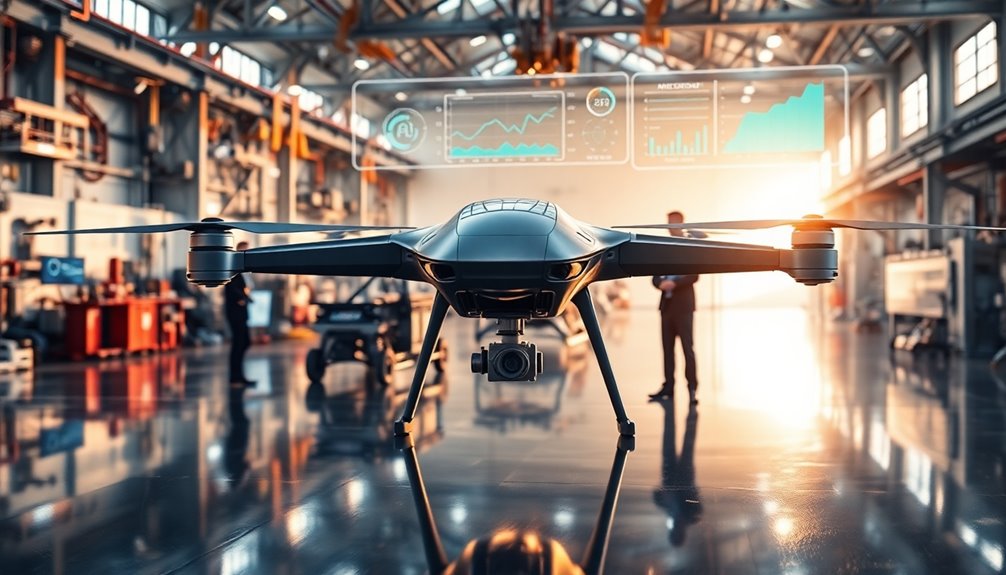
In aerospace, artificial intelligence (AI) is revolutionizing how aircraft operate and are maintained. You'll find that AI algorithms are at the heart of autonomous flight control, enhancing navigation and decision-making processes in aircraft.
Whether it's drones or UAVs, AI is essential for real-time data processing, obstacle avoidance, and intelligent decision-making. With systems like the Intelligent Autopilot System (IAS), aircraft can autonomously handle all flight phases, from takeoff to landing.
Moreover, autonomous navigation systems greatly boost safety and operational efficiency by interpreting sensor data and making real-time decisions. AI also enables precise navigation, improving fuel efficiency through advanced autopilot systems. AI algorithms optimize aircraft designs and simulations, allowing for more efficient engineering and performance.
When it comes to maintenance, AI's predictive capabilities shine. By analyzing sensor data and historical performance, it predicts component failures before they happen, reducing downtime and extending equipment lifespan.
AI-driven visual inspection systems automate the detection of defects in aircraft components, ensuring ideal safety.
The Impact of Digitization

Digitization is dramatically transforming the aerospace industry, often leading to noteworthy improvements in operational efficiency and safety. By streamlining processes, you'll notice reduced complexities and enhanced productivity throughout your operations.
Real-time data analysis and predictive maintenance minimize downtime, optimizing maintenance schedules and cutting costs considerably. The integration of renewable energy sources can further enhance operational sustainability and cost-effectiveness in aerospace.
Automation and robotics in manufacturing processes guarantee precision, speed, and reliability, improving supply chain efficiency. With data-driven decision-making, you can optimize flight operations and anticipate market trends. Moreover, the integration of digital twin technology allows for virtual testing and aircraft design optimization, considerably reducing your reliance on physical prototypes.
On the safety front, advanced analytics help identify potential issues early, allowing for timely interventions. This enhances your overall safety protocols.
Digitalization also fosters seamless coordination in supply chains, ensuring competitive advantage and the highest safety standards.
As you build a digital thread across your operations, you'll eliminate data silos and improve collaboration.
Predictive analytics and AI will help you better forecast inventory needs, enhancing visibility into your supply chains.
With these advancements, you can expect a more efficient and safer aerospace environment that supports future growth and innovation.
Additive Manufacturing Innovations
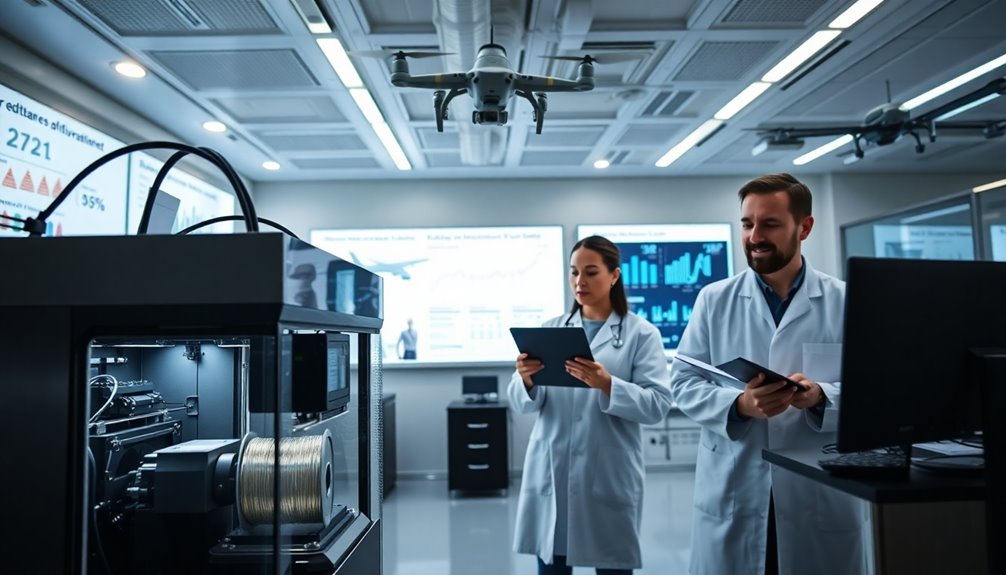
Additive manufacturing innovations are revolutionizing the aerospace industry by enabling the creation of lightweight, complex components that were once unthinkable. You can now design intricate geometries that traditional manufacturing methods simply couldn't achieve. This flexibility not only allows for customized parts but also leads to significant weight reductions, enhancing fuel efficiency and reducing emissions. The use of optimized component design further improves performance metrics, allowing for even more efficient aircraft operations.
With high-performance alloys like titanium and aluminum, you can produce components that maintain strength while drastically cutting down on weight. Imagine optimizing structures to achieve up to 60% weight reduction, as seen with the Airbus A320 cabin hinge bracket.
Rapid prototyping becomes a breeze, allowing you to test designs quickly, get to market faster, and keep your competitive edge sharp.
Cost savings are evident as well. By minimizing material waste and streamlining production, you cut labor costs and reduce the need for extensive storage. You can even create on-demand spare parts, drastically lowering aircraft downtime.
Advancements in Satellite Technology
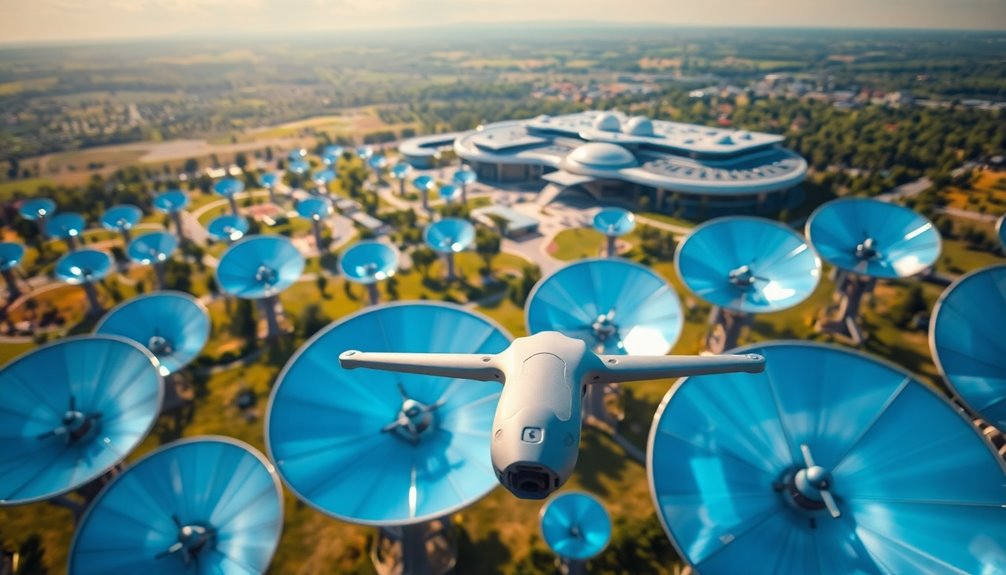
The aerospace industry is rapidly evolving, and advancements in satellite technology are at the forefront of this transformation. You're witnessing a significant shift as satellite-to-cell technology emerges, allowing seamless integration with cellular networks. This innovation opens new avenues for communication, especially with smartphone giants like Apple and Huawei adding emergency messaging services supported by satellite partners.
Starlink's direct-to-cell initiative is set to revolutionize connectivity, with texting services launching in 2024 and data plus calls following in 2025. The U.S. Space Force is also exploring direct-to-cell communications for military applications, highlighting the strategic importance of these advancements.
On the technical side, multi-orbit constellations are gaining traction, combining GEO, LEO, and MEO for enhanced connectivity and reduced latency. Advanced onboard data processing boosts speeds, enabling better remote sensing and higher resolution data. Additionally, the integration of AI/ML technologies in satellite operations is enhancing real-time data analysis and decision-making capabilities.
Furthermore, proliferated low-earth orbit (LEO) constellations are transforming satellite communications, with significant military applications and integrated commercial technologies. Enhanced sensor capabilities provide improved Earth observation, generating actionable climate insights.
These advancements aren't just reshaping communication; they're redefining our understanding of global connectivity and security.
Role of Immersive Technologies
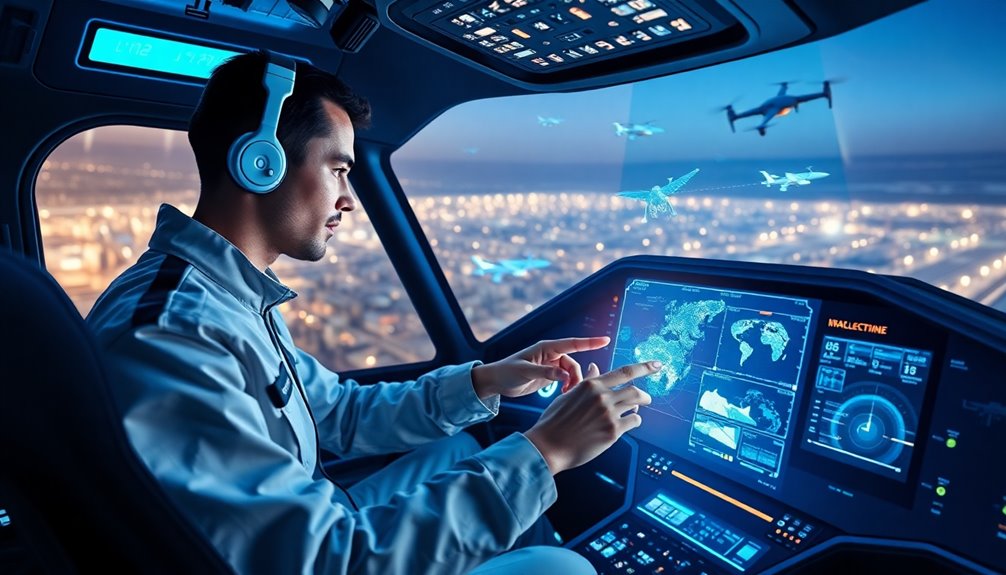
Immersive technologies are transforming the aerospace industry by enhancing design processes, training, and maintenance operations.
With virtual and augmented reality, you can visualize and interact with 3D models early in the design phase, allowing you to quickly identify issues and minimize the need for physical prototypes. This not only reduces costs but also speeds up the design process, making collaboration among engineers from various disciplines more effective. Additionally, immersive environments allow for exploration of complex systems from multiple perspectives, revolutionizing collaboration among geographically dispersed teams.
In training, VR and AR simulate real-life scenarios for pilots, preparing them for emergencies while lowering training expenses. For engineers and technicians, these technologies enhance skill development and knowledge retention through experiential learning, ensuring that critical skills are mastered in a safe environment.
When it comes to manufacturing, immersive technologies validate assembly processes virtually before physical production begins. This integration streamlines assembly planning and testing, reducing the need for physical prototypes and optimizing costs.
Sustainable Propulsion Developments
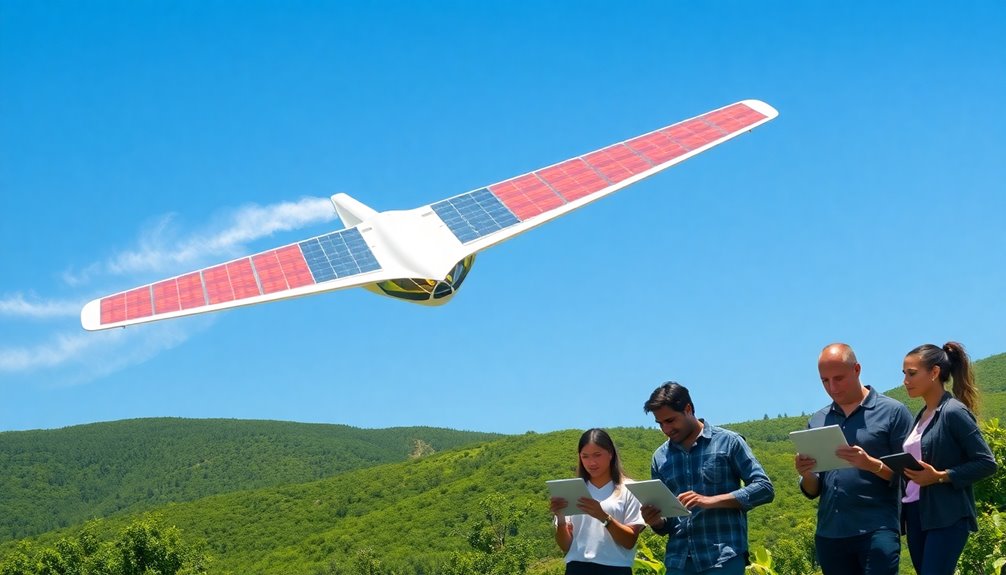
In light of growing environmental concerns, sustainable propulsion developments are reshaping the aerospace industry. You'll find that hybrid-electric propulsion is at the forefront, with companies like Honeywell integrating systems that enhance safety and efficiency.
NASA's HyTEC project aims to cut fuel consumption and carbon emissions by developing a compact core for hybrid-electric turbofan engines. Meanwhile, RTX focuses on modular hybrid electric demonstrators for regional aircraft, emphasizing scalability.
Odys Aviation is pushing boundaries with its hybrid-electric VTOL aircraft, achieving a remarkable 76% reduction in CO2 emissions compared to regional jets. These innovations utilize electric power for short distances while relying on conventional turbines for longer flights.
Advanced materials play a key role too. RTX's ceramic matrix composites outperform current alloys, while NASA's HyTEC project researches high-temperature materials to boost engine performance. Additionally, Honeywell's 1-Megawatt generator is being developed to support these advancements with more efficient power solutions.
Honeywell is also working on robust components compatible with biofuels and hydrogen.
Additionally, sustainable aviation fuels (SAFs) are gaining traction, with Pratt & Whitney testing and certifying SAF blends that promise up to 80% CO2 emissions reduction.
The aviation industry is committed to adopting 100% SAF pathways, further minimizing its environmental impact.
Frequently Asked Questions
How Are Startups Influencing Aerospace Technology Investment Trends?
Startups are reshaping aerospace technology investment trends by introducing innovative solutions and attracting significant funding.
You'll notice their focus on cost-effective launch vehicles, zero-emission powertrains, and hypersonic aircraft, which capture investor interest.
These companies collaborate with established players, enhancing their credibility and market reach.
As a result, you're witnessing a surge in investments, driving growth and pushing the boundaries of what's possible in aerospace technology.
The future looks bright with these dynamic entrants.
What Are the Potential Risks Associated With Emerging Aerospace Technologies?
When considering emerging aerospace technologies, you've got to be aware of several potential risks.
Regulatory changes can delay projects, while manufacturing accidents may increase worker injuries.
Outsourced parts can lead to defects and delays.
Cybersecurity threats loom large, targeting sensitive data and infrastructure.
Plus, economic uncertainties and supply chain complexities can hinder progress.
Staying vigilant and proactive about these risks is essential to guarantee success and safety in your aerospace endeavors.
How Do Government Regulations Impact Aerospace Technology Investments?
Government regulations greatly impact your aerospace technology investments. They establish safety standards and certification processes that you must navigate, influencing the feasibility of new projects.
Compliance with these regulations often requires additional time and resources, affecting your return on investment. Additionally, export controls can limit market access and international partnerships, while government funding opportunities may enhance your investment potential.
Ultimately, understanding these regulations is vital for making informed investment decisions in the aerospace sector.
What Are the Key Metrics for Evaluating Aerospace Tech Investments?
When evaluating aerospace tech investments, you should focus on key metrics like revenue growth, profitability ratios, and debt levels.
Analyze cash flow generation and employ valuation methods such as price-to-earnings and discounted cash flow analysis.
Additionally, assess competitive advantages through proprietary technologies and strong customer relationships.
Don't forget to take into account R&D capabilities and industry-specific factors, including regulations and market demand trends, to guarantee a thorough evaluation.
How Can Companies Protect Their Intellectual Property in Aerospace Innovations?
To protect your intellectual property in aerospace innovations, you should file patents for your unique technologies and designs.
Consider using trade secrets to safeguard proprietary processes and software, especially if patenting isn't feasible.
Make sure to specify IP ownership in contracts with suppliers and explore licensing options to generate revenue.
Stay compliant with international regulations and manage your IP carefully, especially in collaborative projects, to maintain your competitive edge in the industry.
Conclusion
In summary, investing in emerging technologies in aerospace can considerably enhance efficiency and sustainability. By embracing innovations like artificial intelligence, additive manufacturing, and immersive technologies, you're not just keeping pace with industry advancements; you're also paving the way for a greener future. As satellite technology evolves, and sustainable propulsion develops, your commitment to these trends will guarantee you're at the forefront of aerospace transformation. Stay proactive, and you'll reap the benefits of this dynamic landscape.










